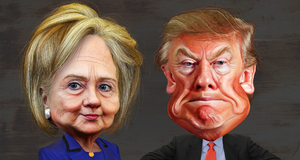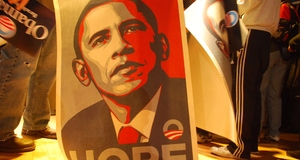The Obama PresidencyE-Electioneering: The Political and Cultural Influence of Social Media in the 2008 and 2012 Presidential ElectionsSymmetrical Social Network and Media Usage in the 2012 Presidential CampaignNoting the Democratic Party’s successes and advantages with online technologies and databases, the Republican party clung onto hopes that they could catch up by 201247. During the 2010 midterm elections, Republicans evened the playing field and proved that the Internet was not solely a Democrat’s game. Republicans learned from Senator McCain’s 2008 campaign mistakes and replicated much of the technology used by Obama’s campaign, including campaign specific mobile apps, user-generated content pages, and personal social networking sites. Republican presidential hopefuls such as Michele Bachmann, Mike Huckabee and Newt Gingrich, among many others, capitalized on these virtual tools to get a head start on building a supporter base and fundraising ahead of the 2012 bid for the nomination48. Tim Pawlenty created a social gaming website which simulated his road to the presidency in a way which supporters could easily follow and play along with during their spare time. On the eve of the start of the 2012 election cycle, the Pew Research Center found that 40% of Republicans used social networks and social media as a primary way to become involved in a campaign, whereas 38% of Democrats reported doing so. This gave a brief indication to the party that they had finally evened the asymmetry which existed in electoral technologies during previous cycles49. By 2011, President Barack Obama amassed almost 20 million followers on his Facebook page from home and abroad, with enormous popularity on his other sites as well. In mid-2011, President Obama hosted a virtual, real time town hall meeting moderated by Facebook CEO Mark Zuckerberg. His followers could tune in, ask the president questions, and share concerns. Over 22,000 Facebook users were reported to have signed up for the virtual event50. On this front, the Republicans still lagged behind, as it seemed Facebook’s loyalty lied with the more liberal end of the political spectrum. By mid-2012, the total amount of Facebook users following President Barack Obama had increased to about 27 million51.Romney Catches UpAfter the Republican nomination was granted to former Massachusetts governor Mitt Romney, the equalized virtual race began. Romney, learning from President Obama’s 2008 successes, became “Mr. Personality” on his social networking pages to counter Obama’s popularity as the so-called ‘celebrity president’52. Immediately, Romney mimicked Obama’s likeability in an effort to reign in undecided voters who may have grown bored or irate with Obama’s presidency after his first term. For starters, he allowed his supporters to get to know him personally on his website and social networking sites by opening up about his personal and family life, as well as informing voters about his positions on current events. On his Facebook page, Mitt Romney took a similar approach to President Obama’s by making himself seem like an everyday American who enjoyed watching Seinfeld and 30 Rock, listening to Johnny Cash, and who had a family tradition of watching Indiana Jones movies at home53. As soon as the Romney-Ryan ticket was announced, the Romney camp further closed the technology gap by creating user-generated content that could be accessed at home or via a mobile app. The Obama campaign then responded by giving their existing website and social networking pages a facelift, in hopes that a new look would generate renewed interest in the already existing content. Realizing that voters may be intrigued in learning more about his opponent, President Obama’s campaign team once again restructured their social networking and social media strategy to reinvigorate their supporter base54. Obama’s Revamped Online StrategyIn 2008, the Obama camp focused on seeming accessible to voters and personable, which was reflected in the utilization of user-generated content and the perceived ability to get to know the candidate personally. In 2012, noting that the opposing side had caught up to this bandwagon and lept on, the Obama campaign tried a new strategy. President Obama’s campaign increased the scale of its social efforts by maintaining the existing pages used in 2008 and also creating “Obama 2012” campaign websites and social networking pages, essentially doubling the content and increasing its reach and availability. They focused their online strategy towards creating more of a digital dialogue between voters and the campaign55. Obama’s social networks appreciated citizen voices by sharing the voters’ anecdotes and retweeting things voters had tweeted at the campaign. Furthermore, the Obama team far outweighed Romney’s through use of direct digital messaging, having posted 614 times during the election cycle compared to 168 for his opponent56. Duplicating their success in 2008, Obama’s campaign created eighteen demographic based user groups, including newer ones like ‘Veterans for Obama,’ ‘Nurses for Obama,’ and ‘Young Americans for Obama,’ while Romney’s team offered no such options on social networks57. Messaging and Iconography on Social Networks and MediaSince the playing field had apparently levelled between both candidates, focus should shift toward the analysis of the messaging and iconography used to determine the impact of social networking and social media use in 2012. In terms of messaging in 2012, both candidates preferred to talk about themselves than their opponents on their respective pages. Barack Obama spoke about himself and his administration’s successes 53% of the time and Mitt Romney spoke of himself and his own previous experience 52% of the time. The degree of political messaging used on his online website decreased drastically on Obama’s end in 2012. Looking back on 2008, both candidates offered their opinions and positions on a very wide array of topics. Four years later, President Obama drastically reduced the issues mentioned in his website’s ‘On the Issues’ page from twenty two to eight, with foreign policy not being one of them58. Studies on the photography and images used by both candidates in the 2012 presidential election have been conducted by experts in communication and cognitive studies. Pew Research reported that Obama’s social networking and social media relied more on alphabetic text, while Romney’s used photography and infographics to communicate. In a study by Trischa Goodnow, the researcher analyzed each of Romney’s 300 Facebook timeline photos and Obama’s 140 timeline photos throughout the course of the campaign59. By analyzing these photographs and studying their potential influence on public opinion, it is obvious that there was intentional strategy of framing political iconography60. Nearly all of Mitt Romney’s photographs featured an American flag and were photographed from the bottom up, so as to immortalize him as the strong, confident candidate ready to take back and defend the country. Nearly all of President Obama’s photos featured him with other Americans, and most of these photos included either a child, young adult, or a minority American. Most of President Obama’s photos featured him looking upward. Once again, this was intentionally shared by the Obama camp to remind voters of the hopeful, visionary leader which they elected four years earlier. The photos shared on Barack Obama’s social networks and website depicted the changing face of America, which he himself represented and wanted to enrich for the future. OutcomesVoter turnout in the 2012 presidential election was not as robust as 2008’s despite disparities between different source’s calculations. According to the Bipartisan Policy Center, voter turnout dipped from 62.3% in 2008 to 57.5% in 201261 62. Figures from the University of California at Santa Barbara calculate 2012 voter turnout at 54.8% compared to 58.2% in 200863. The dip in voter turnout between presidential elections could be attributed to several factors, such as complacency, indecision between candidates, and lower enthusiasm among voters, although it is difficult to empirically analyze such sentiments64. In the context of the campaign’s social media use, it is clear that the trend towards digitization of electoral politics continued and became more entrenched in the science of it. Both campaigns took lessons from 2008 and experimented with newer methods in a political arms race to gain an advantage over online voters. Although the playing field had levelled in 2012, President Obama and the Democrats still seemed to be ahead of their opponents in terms of innovation using the Internet.Continued on Next Page » Suggested Reading from Inquiries Journal
Inquiries Journal provides undergraduate and graduate students around the world a platform for the wide dissemination of academic work over a range of core disciplines. Representing the work of students from hundreds of institutions around the globe, Inquiries Journal's large database of academic articles is completely free. Learn more | Blog | Submit Latest in Political Science |


















